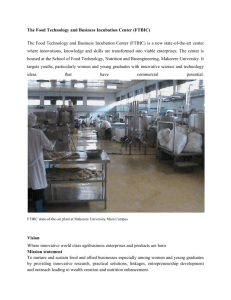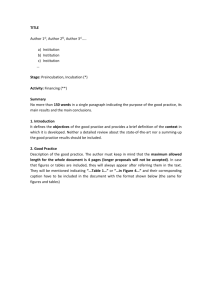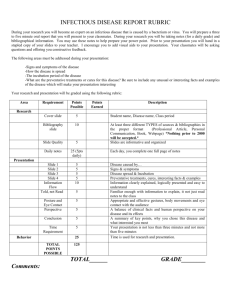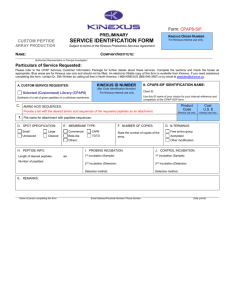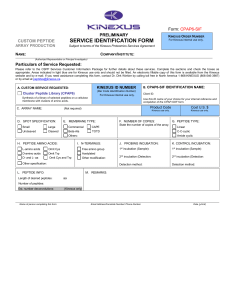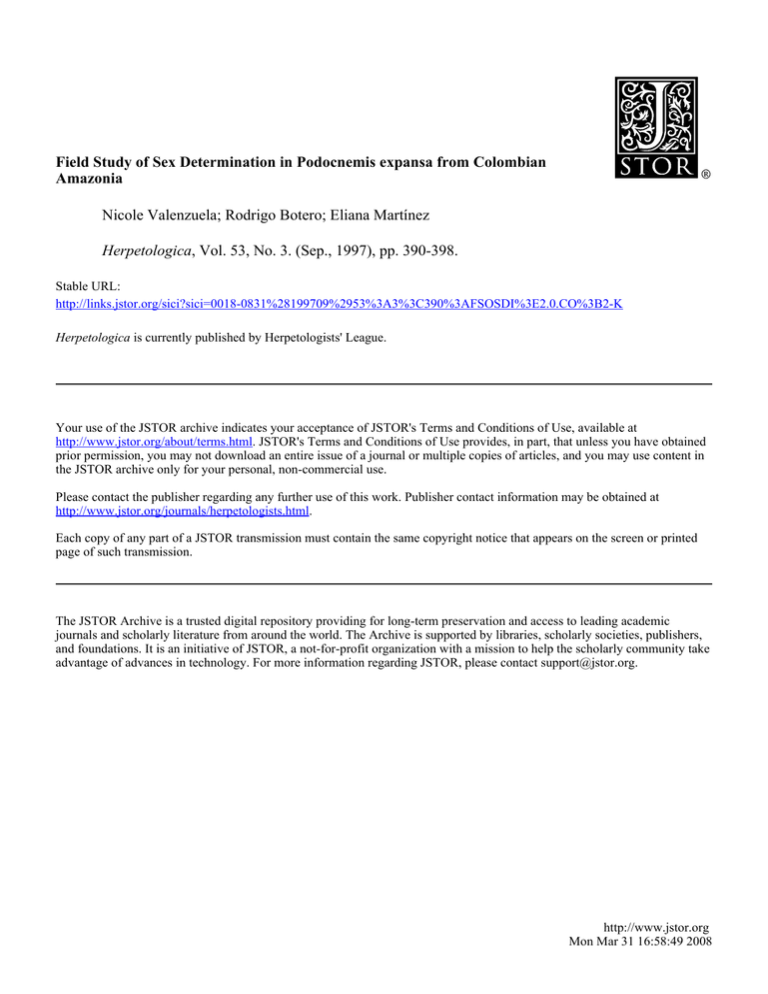
Field Study of Sex Determination in Podocnemis expansa from Colombian
Amazonia
Nicole Valenzuela; Rodrigo Botero; Eliana Martínez
Herpetologica, Vol. 53, No. 3. (Sep., 1997), pp. 390-398.
Stable URL:
http://links.jstor.org/sici?sici=0018-0831%28199709%2953%3A3%3C390%3AFSOSDI%3E2.0.CO%3B2-K
Herpetologica is currently published by Herpetologists' League.
Your use of the JSTOR archive indicates your acceptance of JSTOR's Terms and Conditions of Use, available at
http://www.jstor.org/about/terms.html. JSTOR's Terms and Conditions of Use provides, in part, that unless you have obtained
prior permission, you may not download an entire issue of a journal or multiple copies of articles, and you may use content in
the JSTOR archive only for your personal, non-commercial use.
Please contact the publisher regarding any further use of this work. Publisher contact information may be obtained at
http://www.jstor.org/journals/herpetologists.html.
Each copy of any part of a JSTOR transmission must contain the same copyright notice that appears on the screen or printed
page of such transmission.
The JSTOR Archive is a trusted digital repository providing for long-term preservation and access to leading academic
journals and scholarly literature from around the world. The Archive is supported by libraries, scholarly societies, publishers,
and foundations. It is an initiative of JSTOR, a not-for-profit organization with a mission to help the scholarly community take
advantage of advances in technology. For more information regarding JSTOR, please contact support@jstor.org.
http://www.jstor.org
Mon Mar 31 16:58:49 2008
Herpetologica, 53(3),1997, 390398 O 1997 by The Herpetologists' League, Inc. F I E L D STUDY O F SEX DETERMINATION I N PODOCNEMIS EXPANSA F R O M COLOMBIAN AMAZONIA NICOLEVALENZUELA,'.~~~
RODRIGO
BOTERO,'AND ELIANA
MART~NEZ'
'Fundacio'n Puerto Rastrojo, Camera 10 # 24-76 Of: 602, Bogotci, Colombia
2Department of Ecology and Evolution, State University of New York at Stony Brook,
Stony Brook, NY 11794-5245, USA
ABSTRACT:We studied the relationship between fluctuating temperatures in the field and sex
ratios of the giant river turtle (Podocnernis expansa) obtained from nests incubated in seminatural
conditions using a stepwise logistic regression model. The number of hours above 31 C and mean
temperature above 31 C during day 2 9 3 0 were the two parameters that best explained sex ratios.
We also monitored incubation temperatures of natural nests. Mean incubation temperature and the
combination of mean and variance were not predictors of sex ratio. We found a beach effect on sex
ratios and incubation time. Natural nests hatched earlier than seminatural nests. Length of the
incubation period was negatively correlated with degree days and mean incubation temperature in
seminatural nests but not in natural nests. \Ve found no evidence of an influence of length of the
incubation period on sex ratio. Our results support current conservation practices in the study
region.
Key words: Podocnemis expansa; Turtles; Sex determination; Incubation temperatures; Conservation; Colombia; Amazonia
NUMEROUS
studies have shown the occurrence of various mechanisms of sex determination within the order Testudines,
and in reptiles in general; these mechanisms are comprised by two major categories: genotypic sex determination (GSD)
and environmental sex determination
(ESD) (Bull, 1980; Ewert and Nelson,
1991; Ewert et al., 1994; Janzen and
Paukstis, 1991; Lang and Andrews, 1994;
Viets et al., 1994; Wibbels, 1994). Temperature-dependent sex determination
(TSD) is the most common of the environmental mechanisms found in the turtle
species studied so far (reviewed by Ewert
et al., 1994, and Ewert and Nelson, 1991).
The critical temperature represents the
point where males and females are produced in a ratio of 1:l and is the inflection
point in the sex ratio curves (Mrosovsky
and Pieau, 1991). This reversal of sex ratio
occurs within a narrow range of just 1 C
or 2 C, which is called the transitional
range (Ewert and Nelson, 1991).The temperature-sensitive period (TSP) is the
stage during which sex is determined
(Mrosovsly and Pieau, 1991) and is found
in the second third of the incubation pe'To whom all correspondence should be addressed; e-mail: nvalenzu@life.bio.sunysb.edu.
nod of turtles and other reptiles with TSD
(Bull, 1983). The exact mechanisms by
which incubation temperature affects sexual determination are still unknown.
Podocnemis expansa exhibits temperature-dependent sexual determination
(Alho et al., 1985; Lance et al., 1992), and
current data suggest that the species is
TSDIa (Ewert and Nelson, 1991); that is,
females are produced at high temperatures and males at low ones. Podocnemis
unijilis also exhibits TSDIa (Souza and
Vogt, 1994). Gonads differentiate during
days 2 5 3 5 of incubation in I? expansa (M.
J . Mora, unpublished data). This is within
the second third of the 60 day incubation
period in the population inhabiting the
Middle Caquetci River, Colombian Amazonia. External temperatures are also
known to affect metabolic rates of reptiles
(Bull and Vogt, 1981; Zug, 1993), and constant incubation temperature regimes are
negatively correlated with length of the incubation period (Mrosovsly and Provancha, 1992; Thompson, 1988b). Thus, a relationship between sex ratio and length of
the incubation period is expected in natural conditions as well.
Here we report on the influence of incubation temperature on sex ratios of
September 19971
HERPETOLOGICA
hatchling I? expansa from the Middle Caquet6 River, Colombian Amazonia, produced under seminatural, natural, and artificial conditions. We describe sex-determination in the field based on these data
which comprise (1)parameters of temperature that explain sex ratio, (2) description
of the thermoinfluential period, and (3)
the effect of incubation time. We also report the effect of seminatural and natural
incubation on sex ratios, hatching rates,
and incubation time. Finally, the implications of these data for conservation practices will be discussed.
A N D METHODS
MATERIALS
The data on artificial incubation came
from a laboratory study performed during
1991. Eggs from four different nests laid
the night before were collected from the
bank of the Middle Caquet6 River and
were transported to Bogot6. Two or three
days after oviposition, eggs from each nest
were assigned to four incubators set at
26.5 C, 28.5 C, 30.5 C, and 32.5 C (?0.5
C). Humidity was maintained at similar
levels in all four incubators, although no
exact measurement of water potential was
taken.
The remaining data come from a study
on natural and seminatural incubation
conducted during the reproductive season
1993-1994. Natural and transported nests
came from three different beaches along
the Middle Caquet6 River: the Yarumal,
the Centro, and the Guadual beaches.
From each of the three beaches, we chose
and transported nests laid the night before
so that all the nests were of the same,
known age. We constructed seminatural
nests as 4 X 2 m wood boxes divided into
eight 1 X 1 X 1 m compartments filled
with sand. Each 1m3 compartment housed
the eggs of just one clutch. From each
clutch, we used half the number of eggs
(approximately 40). Sand used in the incubation of all transported nests came
from a single beach. We placed all nests at
approximately the same depth within the
compartments. These boxes were located
on top of a high beach to avoid the danger
of a sudden increase in water level, which
could drown the eggs. A total of 30 clutch-
391
es, 10 per beach, were incubated in this
way. On the same three beaches, an additional 15 clutches were monitored where
they were laid, five per beach.
We recorded temperatures within nests
daily at 0700, 1300, and 1900 h, as well as
every hour (0100 h to midnight) one day
per week. From day 25 until day 35 of incubation, we recorded temperatures every
other hour. Temperature records were
taken inside the egg chamber with a thermometer accurate to 20.1 C. We removed
hatchlings from seminatural and natural
incubation conditions from the nests after
hatching but before they emerged by
themselves. At least two nests from each
treatment (seminatural and natural incubation), and each beach, were chosen to
determine sex-ratios (% of females) among
all hatchlings. In addition, we sexed all
hatchlings from the artificial incubation experiment in BogotB. This was performed 3
mo after hatching. We determined sex by
means of radioimmunoassay (RIA) of testosterone levels in the blood of the young
turtles 4 h after injection with FSH, which
stimulated higher than normal levels of
testosterone (Lance and Callard, 1979;
Lance et al., 1992; Owens et al., 1978).
This technique had been used and standardized for P: expansa in a previous study
(Lance et al., 1992) using 178 hatchlings,
which included the hatchlings from the artificial incubation reported here, plus
hatchlings collected from the wild along
the Middle Caquet6 River. In that study,
comparisons of sex determination by RIA,
gonadal inspection, and histological dissection of the same individuals demonstrated
that the RIA method gave a perfect
(100%) match with actual sex.
Temperatures of seminatural nests were
used for the regression analysis with sex
ratios. We dvided the data from days
2 5 3 5 into daily groups, and their relationship with sex ratio was determined using a
stepwise logistic regression (Sokal and
Rohlf, 1995; SAS version 6.11, 1994). This
was done to determine which days explained most of the variance in sex ratios.
One of the parameters of temperature
tested in the regression analysis was the
number of hours >31 C for each of those
IVol. 53. No. 3
HERPETOLOGICA
392
-
-
TABLE
1.-Sex
Nest
ratios, incubation time, and temperature of seminatural and natural nests.
Incubation
time
Beach
Treatment
Guadual
Guadual
Guadual
Guadual
Yarumal
Yarumal
Centro
Centro
Centro
Guadual
Guadual
Yarumal
Yarumal
Centro
Centro
Seminaturd
Seminaturd
Seminatural
Seminatural
Seminatural
Seminatural
Seminatural
Seminatural
Seminatural
Natural
Natural
Natural
Natural
Natural
Natural
% Female
71
No. h day
2930
Mean T >31 C
with T >31 C day 2 9 3 0
days. Mean temperatures >31 C were also
tested in the regression analysis with sex
ratio. Given that we took records for some
nests on alternate days than others, the
daily temperature records were classified
as two-day periods: days 25-26,27-28,2930, 3 1 3 2 , and 3 3 3 4 .
We calculated the relationship between
sex ratio and length of incubation period
using logistic regression as well. We calculated the correlation between mean incubation temperature and length of the incubation period, and the correlation between degree days and incubation time.
We defined degree days (DD) as the heatunits accumulated above a threshold temperature (Baskerville and Emin, 1969). In
this case, we calculated DD as the roduct
of the number of days during whic mean
tem erature was >28.5 C (below which no
hatcRing was obtained under laboratory
conditions in 1991) and the mean of the
temperatures over those days,
the description made by Schwarzkopf
fO1lO"in%an
Brooks (1985). A nested ANOVA (Sokal
and Rohlf, 1995) was performed to detect
differences in sex ratios and length of incubation period between nests in natural
beaches and those incubated in the seminatural nests, as well as to detect any
beach effects.
Sex Ratios from Natural versus Seminatural Zncubation Overall hatching rates were 95% under
seminatural and natural (though protected) conditions. The sex ratios reported
here (Table 1) correspond to all surviving
hatchlings (some hatchlings were lost to
predation by domestic dogs before sexing,
but it was assumed that this predation was
sex-independent and thus would not bias
the sex ratios). Results of the nested ANOVA showed that there was no significant
difference between sex ratios obtained
from nests under seminatural incubation
and those under natural incubation, which
were not removed from where they had
been laid by the females (P > 0.05). However, a beach effect was present (P < 0.05)
(Table 2). Nests from Guadual beach
showed a significantly smaller proportion
of females than Yarumal beach (t = 3.80,
P < 0.005) and Centro beach (t = 3.66, P
< 0.005), but no significant difference was
found in the sex ratios between Yarumal
beach and Centro beach (t = 0.35, P >
0.05).
RESULTS
Artijicial Zncubation
Incubators produced 100% males at
30.5 C and 69.7% males at 32.5 C . All em-
Zncubation Temperature and Sex Ratios
in the Field
Daily mean temperatures for all nests
monitored in the field ranged from 26-31
R
bryos incubated at 26.5 C died before 10
days of development, and all at 28.5 C
died before 25 days of development.
HERPETOLOGICA
September 19971
TABLE2.-Nested
393
ANOVA of sex ratios and incubation time.
Source of variation
df
SS
MS
F,
Sex ratio
Between incubation conditions
Among beaches
Within beaches
1
4
9
62.5
929.1
338.0
62.5
232.3
37.6
0.27
6.18*
Incubation time
Between incubation conditions
Among beaches
Within beaches
1
4
9
792.1
175.6
73.9
792.1
43.9
8.2
18.0*
5.3*
P
>0.05
<0.05
<0.005
<0.025
* Significant difference.
C. Sex ratio of all field nests ranged from
73.3-100% females. Of the number of
hours >31 C during the critical period
(days 25-35), only those from day 29-30
(Table 1)were included in the model by
the logistic regression with stepwise procedure (P = 0.0001). Under this model,
day 29-30 explained most of the variance
in sex ratios, and no other variable (number of hours >31 C for any other day) contributed significantly when added to the
model (Table 3 ) . We also analyzed the influence of the mean of the temperatures
>31 C on sex ratio by means of the stepwise logistic regression. Again, only the
mean temperature >31 C for the day
29-30 was incorporated in the model (P =
0.0001). In order to assess whether some
other variables other than those from day
29-30 had an indistinguishable fit to the
data that could be obscured by the stepwise procedure, we calculated the logistic
regression of each variable independently.
All other variables showed a significantly
worse fit to the data, leaving those from
day 29-30 as best predictors of sex ratio.
TABLE3.-Lagistic
Length of Incubation Period
Mean length of the incubation period
was 77.3 days for seminatural nests, 62.5
for natural nests, and 71.4 days when combined. The nested ANOVA showed significant differences between length of the incubation periods in natural and seminatural nests (P < 0.005). A beach effect was
found in the same analysis (P < 0.025) (Table 2). Nests from Centro beach showed
significantly shorter incubation times than
nests from Guadual beach (t = 3.36, P <
0.005) and Yarumal beach (t = 2.46, P <
0.025), but no differences were found between Guadual and Yarumal beaches (t =
0.58, P > 0.05). The effect of incubation
conditions explained 82% of the variation
in incubation time while the beach effect
explained 11.5%. We could not find evidence of a relationship between length of
the incubation period and sex ratio with
our field data. No significant correlation
was found between mean To over the entire incubation period and incubation time
for natural nests nor for the combined data
from natural and seminatural nests, but it
regression with stepwise procedure; analysis of maximum likelihood estimates.
Vanable
df
Parameter
eshmate
Standard
error
Wald
x2
x2
Number of h > 31 C day 29-30
Coefficient of H,, (b)
Intercept
1
1
Mean > 31 C day 29-30
Coefficient of M,, (b)
Intercept
1
1
0.49
0.46
0.12
0.38
16.85
1.42
>0.0001
>0.23
0.71
-21.42
0.17
5.66
16.58
14.31
>0.0001
>0.0002
No other variable met the 0.05 criterion to be incorporated into the model.
P
394
HERPETOLOGICA
was significant for the seminatural nests
alone (r = -0.74, P < 0.05). However, a
significant, negative correlation was found
between DD and length of the incubation
period (r = -0.85, P < 0.05).
Incubation Temperature and Sex Ratios
According to our preliminary laboratory
data, pivotal temperature in Podocnemis
expansa must be >32.5 C (30.3% females
were produced at that temperature) but
probably <34.5 C (Alho et al., 1985). If
the critical temperature lies between 32.5
C and 34.5 C, it would mean that P. expansa has the highest ~ i v o t a temperature
l
reported to date for any species of turtle
(Ewert et d . , 1994). Females of this species lay their eggs on the open, sunny parts
of the beach, where temperatures get very
high. Sudden increases in water level occur frequently during the middle or the
end of the reproductive season (von Hildebrand et al., 1988) and may select for
rapid development of the embryos. A high
pivotal temperature in this species could
then be explained as a compromise between nesting in hot places for rapid development (Ewert et al., 1994) and the
production of a less biased sex ratio.
Bull (1985) suggested that with variable
field data one must first identify the measures of temperature that associate with
sex-ratio, and then find the time interval
that shows the strongest association between sex-ratio and that measurement.
This justified the subdivision of temperature data into weekly units, which were
tested independently of each other for a
correlation with sex ratio (Bull, 1985). Because our temperature records showed a
daily pattern [as given by a test of autocorrelation of the time series data of temperature for each nest (P < 0.05)], we divided the data from days 25-35 into daily
groups. In the studies conducted so far, association between parameters of temperature and sex ratios have been calculated
using parametric correlation. Because sex
ratio is a binomial variable, and thus contains non-normally distributed standard
errors, associations based on parametric
[Vol. 53, No. 3
correlations may not meet the statistical
assumptions of the test. Therefore, logistic
regression is a more appropriate mathematical model to analyze such data (Sokal
and Rohlf, 1995) and to find the association between sex ratio and one or more
independent variables. One of the parameters of temperature tested in the regression analysis was hours >31 C for each of
those days. This temperature was chosen
because during the 1991 laboratory study
at constant temperature regimes, 100%
males were produced at 30.5 C and 69.7%
males were produced at 32.5 C, suggesting
that temperatures >30.5 C were somehow
responsible for the production of females.
In addition, we also tested for the association between sex ratio and mean temperatures >31 C, because the time spent at a
temperature 1 C above a threshold will not
be equivalent to the same time spent at a
temperature 5 C above that threshold
(Georges, 1989). Our results show that the
number of hours >31 C and the mean
temperature >31 C during the day 29-30
explained most of the variance in sex ratios. Georges (1992) also found that temperature experienced by nests in the field
during only two incubation days best explained the sex ratios produced by Carettochelys insculpta (thermal scores during
days 30 and 35 of incubation). The positive
relationship found in our study is consistent with both laboratory data and some
observations at the Trombetas station in
Brazil (Alho et al., 1985), where higher
proportions of females were produced at
higher temperatures. This, however, is a
surprising result and is in contrast with the
thermosensitive period reported for Podocnemis unijilis, which extends for more
than the second third of incubation (Souza
and Vogt, 1994). We have defined day
2 9 3 0 as the thermoinfluential period, because TSP has been defined as the time
interval of incubation when temperatures
affect sex ratio, and we cannot rule out minor influences of days different from day
2 9 3 0 . These results would predict a male
biased sex ratio from nests that do not experience temperatures >31 C and with a
mean temperature <31 C during days
29-30 of incubation (or the equivalent de-
September 19971
HERPETOLOGICA
velo~mentalstage). Further work is necessary to test whether the thermoinfluencial period (i.e., the period that statistically
best explains sex ratios) corresponds to the
TSP for the species or not. It is also necessary to validate the biological significance of such a short thermoinfluencial
period found in this study and the predictions that derivate from it. Complete temperature records as well as developmental
series are essential to answer these questions properly.
Some studies conducted in the field
have found that mean and variance of incubation temperatures or hours above a
critical temperature during the critical period could be used as predictors of sex ratios (Bull 1985; Bull and Vogt, 1979; Morreale et al., 1982; Mrosovsky and Provancha, 1992; Mrosovsky et al., 1984, 1992;
Pieau, 1982; Souza and Vogt, 1994; Spotila
et al., 1987; Standora and Spotila, 1985;
Wilhoft et al., 1983). However, it has also
been suggested that mean and variance of
temperatures in the field are not the best
predictors of sex ratios (Georges, 1989;
Schwarzkopf and Brooks, 1985; this
study). Georges (1989) developed a mathematical model to analyze data on fluctuating incubation temperatures provided
that variances are homogeneous over the
incubation period. There are three maiq
reasons why the mathematical model developed by Georges (1989) is inappropriate for our data. First, incubation temperatures within nests in the field fluctuate
daily in such a way that variances are not
constant, violating one of the model's assumptions. Second, the pivotal temperature has not yet been determined for Podocnemis expansa, and Georges' (1989)
model considers the proportion of development above and below the critical temperature as the major,,factor responsible
for female and male biased sex ratios in
the field. However, even without knowing
the exact value of the critical temperature
for I? expansa, it is worth noting that daily
and overall mean temperatures monitored
in field nests were below the range comprising the presumed critical temperature
(32.5-34.5 C ) ,which according to Georges
(1989) should produce only males. Our
395
data from the field covered the upper
range of sex ratios (70-100%). Georges's
(1989) model also failed to predict sex ratios of P unijilis in the case reported by
Souza and Vogt (1994).
D e s ~ i t e the statistical inconveniences
menti&ed before. we calculated the correlation between sex ratios and mean temperature, and the combination of mean
and variance, to compare our data with the
literature. We found no significant correlation between sex ratio and any of these
variables. This result indicates that mean
tem~eratureor the combination of mean
andkariance (during the entire incubation
period or during the critical period) were
not predictors of sex ratio in our study (P
> 0.05). On the other hand, significant
product moment correlations were found
for the dav 2 9 3 0 between number of
hours when nest temperatures remained
>31 C (or the mean of those temperatures) and sex-ratio (r = 0.92 and r = 0.95
respectively, P < 0.001 in both cases).
Thus, the results of this study would have
been the same had correlation analvsis
been used. Other factors that might 'account for variance in sex ratios from natural nests are the date of oviposition, nest
substrate (and humidity), nest depth, position of the eggs within the nest, and metabolic heat (Souza and Vogt, 1994;
Thompson, 1988a). In our study, the first
three factors were eliminated. because
nests from each beach were of the same
and known age, the sand used for the seminatural nests came from the same beach,
and the eggs were placed at approximately
the same depth within each compartment.
Metabolic heat must be an important factor for large clutches (Thompson, 1988a)
as those of Podocnemis expansa. We divided the clutches and placed half the eggs
in each seminatural nest. It is not known
how this reduced the effect of metabolic
heat, but the number of eggs did not affect
sex ratios in a study on Podocnemis unijilis
(Souza and Vogt, 1994). ~ d d i t i o n # ~the
,
differences in location of the seminatural
nests with resDect
to each other could also
I account for part of the temperature variation recorded. The position of the eggs
within the egg chamber is yet another faci
396
HERPETOLOGICA
tor that could not be accounted for, because temperature records were taken at
just one position within the egg chamber.
Finally, we did not measure or control the
water potential of the seminatural nests.
Differences of water potential among
nests could have existed, which might explain some of the variation in sex ratio production because the hydric environment
may affect sex determination (Gutzke and
Paukstis, 1983; Paukstis et al., 1984;
Thompson, 1988b).
Nests within each beach used in this
study were laid on the same night. Thus,
nests within beaches might have experienced more similar temperature schedules
than nests from different beaches. The
synchrony of development experienced by
nests coming from the same beach generated in this way may be the cause of the
beach effect on sex ratio found in our data,
as well as the beach effect found on incubation times.
Length of the Incubation Period
Natural nests were found to have shorter incubation periods when compared to
seminatural ones. Higher temperatures are
expected to increase metabolic rates (Ackerman, 1977; Zug, 1993) and thus shorten
incubation period. In our laboratory experiments, we observed a negative relationship between incubation temperatures
and length of the incubation period. This
has also been reported for other species
(Jeyasuria et al., 1994). Eggs of l? expansa
incubated at 34.5 C and 33.4 C hatched
after 50 days of incubation, those at 32.5
C hatched after 57 days, and those incubated at 30.5 C hatched after 62 days. In
our study of seminatural and natural nests,
a significant negative correlation was
found between DD and length of the incubation period. However, mean temperature was not a good predictor of incubation time. Length of the incubation period
was not predctor of sex ratio. It has been
stated that higher temperatures are responsible for higher proportion of females.
It was thus expected that shorter incubation periods at higher temperatures will
produce a higher proportion of females.
Our results did not support such expecta-
[Vol. 53, No. 3
tions and suggest that additional variables,
such as water potential, need to be controlled for or measured in the future in
order to account for variation of sex ratios
in the field. Further studies are necessary
to account for the discrepancies that we
found.
Mean length of the incubation period
recorded for natural nests (62.5) is longer
than that reported by Alho et al. (1985) for
the population of Podocnemis expansa in
Brazil. This difference with the data reported for Brazil may be due to climatic
differences between both regions or to
geographical differentiation of the populations from Colombia and Brazil.
We have described the sex determination of Podocnemis expansa during a field
season in the Colombian Amazonia. The
~arametersthat best emlained the sex raiios produced are (1)th; number of hours
>31 C and (2) mean temperatures >31 C
during the day 29-30 of incubation. Further work is necessary to determine the
critical temperature and to define conclusively the thermosensitive and thermoinfluencial periods in terms of development.
It is also necessary to corroborate the validity of 28.5 C and 31 C as the developmental and female-inducing thresholds respectively. Existing models did not explain
the sex ratios found in our field study. New
models that take into account fluctuatine
0
temperatures with heterogeneous variances need to be developed in order to
account for TSD in the field. At the same
time, it is essential for us to obtain complete temperature records in the field, together with data on additional variables
such as water potential and development,
in order to test such models.
Results concerning hatchling rates and
the comparison of natural to seminatural
sex ratios are encouraging with regards to
conservation and management plans for
this endangered species. Hatchling success
was much higher in seminatural incubation conditions (95%) than in natural (unprotected) conditions (37%) (von Hildebrand et al., 1988). No significant difference in sex-ratio was found between nat-
fluence of the hydric environment on sexual differural and seminaturally incubated nests,
entiation of turtles. J. Exp. Zool. 226:467469.
which suggests the great potential of the JANZEN,
F. J., AND G. L. PAUKSTIS.
1991. A prelimseminatural incubation as part of the effort
inary test of the adaptive significance of environto increase population numbers of I? exmental sex determination in reptiles. Evolution
45:435440.
pansa without distorting natural sex-ratios.
JEYASURIA,
P., W. M. ROOSENBURG,
A N D A. R.
PLACE. 1994. Role of P-450 aromatase in sex determination of the diamondback terrapine, Malaclemys terrapin. J. Exp. Zool. 270:95-111.
LANCEV., AND I. P. CALLARD.
1979. Plasma testosterone levels in male turtles, Chrisemys picta, following single injections of mammalian, avian and
teleostean gonadotropins. Gen. Comp. Endoc. 31:
435441.
LANCE v, N. VALENZLELA,
A N D P. \'ON HILDEBRAN.
1992. A hormonal method to determine the sex of
hatchling giant river turtles, Podocnemis expansa.
Application to endangered species research. Am.
Zool. 32:lGA.
LANG,J. W., A N D H. V. ANDREW. 1994. Temperature-dependent sex determination in crocodilians.
J. Exp. Zool. 270:2844.
MORREALE,
S. J., G. J. RUIZ,J. R. SPOTILA,AND E.
A. STANDORA.
1982. Temperature-dependent sex
ACKERMAN,
R. A. 1977. The respiratory gas exdetermination: Current practices threaten conserchange of sex turtle nests (Chelonia, Caretta). Resvation of sea turtles. Science 216:1245-1247.
pir. Physiol. 31:18-38.
N., A. BASS,L. A. CORLISS,
J. I. RICHALHO,C. J. R., T. M. S. DANNI,AND L. F. M. PADUA. MROSOVSKY,
.4RDSOS, .4ND T. H. RICHARDSON.
1992. Pivotal
1985. Temperature-dependent sex determination
and beach temperatures for hawksbill turtles nestin Podocnemis expansa (Testudinata: Pelomedusiing in Antigua. Can. J. Zool. 70:1920-1925.
dae). Biotropica 17:75-78.
N., S. R. HOPKINS-MURPHY,
AND J. I.
BASKERVILLE,
G . L., AND P. EMIN.1969. Rapid es- MROSOVSKY,
RICHARDSON.
1984. Sex ratio of sea turtles: Seatimation of heat accumulation from maximum and
sonal changes. Science 225:739-741.
minimum temperatures. Ecology 50:514517.
N., AND C. PIEAU. 1991. Transitional
BULL,J. J. 1980. Sex determination in reptiles. Q. MROSOVSKY,
range of temperature, pivotal temperatures and
Rev. Biol. 55:3-21.
thermosensitive stages for sex determination in
. 1983. Evolution of Sex determining Mechreptiles. Amphibia-Reptilia 12:169-179.
anisms. Benjamin/Cummings, Menlo Park, CaliforMROSOVSKY,
N., A N D J. PRO\'ANCHA.
1992. Sex ratio
nia.
of hatchling loggerhead sea turtles: Data and esti. 1985. Sex ratio and nest temperature in turtles: Comparing field and laboratory data. Ecology
mates from a 5-year study Can. J. Zool. 70:530538.
66:1115-1122.
BULL,J. J., A N D R. C. VOGT. 1979. Temperature- OWENS D. m7.,J. R. HENDRICKSON,
V. LANCE,.4KD
dependent sex determination in turtles. Science
I. P. CALLARD.
1978. A technique for determining
206:11861188.
sex of immature Chelonia midas using a radioim. 1981. Temperature-sensitive periods of sex
munoassay. Herpetologica 34:270-273.
determination in emidid turtles. J. Exp. Zool. 218: PAUKSTIS,
G. L., W. H. N. GUTZKE,
4 N D G. C. PACK435-440.
ARD. 1984. Effects of substrate water potencial
EWERT,M. A., D. R. JACKSON,
A N D C. E. NELSON.
and fluctuating temperatures on sex ratios of hatch1994. Patterns of temperature-dependent sex deling painted turtles (Chysenzys picta). Can. J. Zool.
termination in turtles. J. Exp. Zool. 270:3-15.
62:1491-1494.
EWERT,M. A,, A N D C. E. NELSON.1991. Sex de- PIEAUC. 1982. Modalities of the action of tempertermination in turtles: Diverse patterns and some
ature on sexual differentiation in the field-develpossible adaptive values. Copeia 1991:50-69.
oping embryos of the European pond turtle Emys
GEORGES,A. 1989. Female turtles from hot nests:
J. Exp. Zool. 220:353-360.
o r b i ~ t l a r i (Emydidae).
.~
Is it duration of incubation or proportion of devel- SAS. 1994. Version 6. First Edition. SAS Institute,
opment at high temperature that matters? OecolInc., Cary, North Carolina.
ogia (Berlin) 81:323-328.
SCHWARZKOPF,
L., AND R. J. BROOKS.1985. Sex de. 1992. Thermal characteristics and sex determination in northern painted turtles: Effects of
termination in field nests of the pig-nosed turtle,
incubation at constant and fluctuating temperaCarettochelys insculpta (Chelonia: Carettochelyditures. Can. J. Zool. 63:2543-2547.
dae), from Northern Australia. Aust. J. Zool. 40: SOKAL,R. R., A N D F. J. ROHLF. 1995. Biometry, 3rd 511521.
Ed. W. H. Freeman, San Francisco, California. GUTZKE,W. H. N., AND G . L. PAUTKSTIS.
1983. In- SOLZ.4, R. R. DE, A N D R. C. VOGT. 1994. Incubation Acknowledgments.-We thank Dr. M. E . Patarroyo
for allowing us to perform the radioimmunoassays at
the Instituto de Inmunologia, Hospital San Juan De
Dios, Colombia. We also give special thanks to the
people from the Middle Caquetd. River in Colombia
who participated actively in this project. We thank
Dr. F. J. Rohlf for his suggestions on data analysis
and D. Adams for his help and suggestions on the
manuscript. This study was funded by The Ford
Foundation as part of the project CEICA and was
performed with the authorization and help of INDERENA, Colombia. This is contribution number
994 from the Program in Ecology and Evolution at
The State University of New York at Stony Brook.
398
HERPETOLOGICA
[Vol. 53, No. 3
temperature influences sex and hatchling size in
E. NELSON.1994. Sex determination in squamate
the neotropical turtle Podocnemis unijilis. J. Herreptiles. J. Exp. Zool. 270:4556.
\'ON HILDEBRAND,
P., C. SAENZ,M . C. PERUELA,
petol. 28:453-464.
SPOTILA,J. R., E. A. STANDORA,
S. J. MORREALE, AND C. CARO.1988. Biologia reproductiva y manejo de la tortuga Charapa (Podocnemis expansa)
AND G. J. RUIZ. 1987. Temperature dependent sex
en el bajo Rio CaquetA. Colombia Amazdnica 3:
determination in the green turtle (Chelonia m y 89-112.
dm): Effects on the sex ratio on a natural nesting
WIBBELST. 1994. Temperature-dependent sex debeach. Herpetologica 41:74-81.
termination: A mechanistic approach. J. Exp. Zool.
STANDORA
E. A,, AND J. R. SPOTILA.1985. Temper270:71-78.
ature dependent sex determination in sea turtles.
WILHOFT, D. C., E. HOTALING,A N D P. FRANKS.
Copeia 1985:711-722.
1983. Effects of temperature on sex determination
THOMPSON,
M. B. 1 9 8 8 ~ .Nest temperatures in the
in embryos of the snapping turtle, Chelydra serpleurodiran turtle, Emydura mucquarii. Copeia
pentina. J . Herpetol. 17:3842.
1988:996-1000.
ZUG, G. R. 1993. Herpetology: An Introductory Bi. 1988b. Influence of incubation temperature
ology of Amphibians and Reptiles. Academic Press,
and water potencial on sex determination in EmySan Diego, California.
dura macquarii (Testudines: Pleurodira). Herpetologica 44:8&90.
Accepted: 17 September 1996 VIETS B. E., M . A. EWERT,L. G. TALENT,AND C.
Associate Editor: Daniel Formanowicz, Jr. http://www.jstor.org
LINKED CITATIONS
- Page 1 of 3 -
You have printed the following article:
Field Study of Sex Determination in Podocnemis expansa from Colombian Amazonia
Nicole Valenzuela; Rodrigo Botero; Eliana Martínez
Herpetologica, Vol. 53, No. 3. (Sep., 1997), pp. 390-398.
Stable URL:
http://links.jstor.org/sici?sici=0018-0831%28199709%2953%3A3%3C390%3AFSOSDI%3E2.0.CO%3B2-K
This article references the following linked citations. If you are trying to access articles from an
off-campus location, you may be required to first logon via your library web site to access JSTOR. Please
visit your library's website or contact a librarian to learn about options for remote access to JSTOR.
Literature Cited
Temperature-Dependent Sex Determination in Podocnemis expansa (Testudinata:
Pelomedusidae)
Cleber J. R. Alho; Tania M. S. Danni; Luiz F. M. Padua
Biotropica, Vol. 17, No. 1. (Mar., 1985), pp. 75-78.
Stable URL:
http://links.jstor.org/sici?sici=0006-3606%28198503%2917%3A1%3C75%3ATSDIPE%3E2.0.CO%3B2-A
Rapid Estimation of Heat Accumulation from Maximum and Minimum Temperatures
G. L. Baskerville; P. Emin
Ecology, Vol. 50, No. 3. (May, 1969), pp. 514-517.
Stable URL:
http://links.jstor.org/sici?sici=0012-9658%28196905%2950%3A3%3C514%3AREOHAF%3E2.0.CO%3B2-V
Sex Determination in Reptiles
J. J. Bull
The Quarterly Review of Biology, Vol. 55, No. 1. (Mar., 1980), pp. 3-21.
Stable URL:
http://links.jstor.org/sici?sici=0033-5770%28198003%2955%3A1%3C3%3ASDIR%3E2.0.CO%3B2-Z
Sex Ratio and Nest Temperature in Turtles: Comparing Field and Laboratory Data
J. J. Bull
Ecology, Vol. 66, No. 4. (Aug., 1985), pp. 1115-1122.
Stable URL:
http://links.jstor.org/sici?sici=0012-9658%28198508%2966%3A4%3C1115%3ASRANTI%3E2.0.CO%3B2-5
http://www.jstor.org
LINKED CITATIONS
- Page 2 of 3 -
Temperature-Dependent Sex Determination in Turtles
J. J. Bull; R. C. Vogt
Science, New Series, Vol. 206, No. 4423. (Dec. 7, 1979), pp. 1186-1188.
Stable URL:
http://links.jstor.org/sici?sici=0036-8075%2819791207%293%3A206%3A4423%3C1186%3ATSDIT%3E2.0.CO%3B2-%23
Sex Determination in Turtles: Diverse Patterns and Some Possible Adaptive Values
Michael A. Ewert; Craig E. Nelson
Copeia, Vol. 1991, No. 1. (Feb. 7, 1991), pp. 50-69.
Stable URL:
http://links.jstor.org/sici?sici=0045-8511%2819910207%293%3A1991%3A1%3C50%3ASDITDP%3E2.0.CO%3B2-N
A Preliminary Test of the Adaptive Significance of Environmental Sex Determination in
Reptiles
Frederic J. Janzen; Gary L. Paukstis
Evolution, Vol. 45, No. 2. (Mar., 1991), pp. 435-440.
Stable URL:
http://links.jstor.org/sici?sici=0014-3820%28199103%2945%3A2%3C435%3AAPTOTA%3E2.0.CO%3B2-W
Temperature-Dependent Sex Determination: Current Practices Threaten Conservation of Sea
Turtles
Stephen J. Morreale; Georgita J. Ruiz; James R. Spotila; Edward A. Standora
Science, New Series, Vol. 216, No. 4551. (Jun. 11, 1982), pp. 1245-1247.
Stable URL:
http://links.jstor.org/sici?sici=0036-8075%2819820611%293%3A216%3A4551%3C1245%3ATSDCPT%3E2.0.CO%3B2-9
Sex Ratio of Sea Turtles: Seasonal Changes
N. Mrosovsky; Sally R. Hopkins-Murphy; James I. Richardson
Science, New Series, Vol. 225, No. 4663. (Aug. 17, 1984), pp. 739-741.
Stable URL:
http://links.jstor.org/sici?sici=0036-8075%2819840817%293%3A225%3A4663%3C739%3ASROSTS%3E2.0.CO%3B2-T
Incubation Temperature Influences Sex and Hatchling Size in the Neotropical Turtle
Podocnemis unifilis
Roselis Remor de Souza; Richard C. Vogt
Journal of Herpetology, Vol. 28, No. 4. (Dec., 1994), pp. 453-464.
Stable URL:
http://links.jstor.org/sici?sici=0022-1511%28199412%2928%3A4%3C453%3AITISAH%3E2.0.CO%3B2-F
http://www.jstor.org
LINKED CITATIONS
- Page 3 of 3 -
Temperature Dependent Sex Determination in Sea Turtles
Edward A. Standora; James R. Spotila
Copeia, Vol. 1985, No. 3. (Aug. 5, 1985), pp. 711-722.
Stable URL:
http://links.jstor.org/sici?sici=0045-8511%2819850805%293%3A1985%3A3%3C711%3ATDSDIS%3E2.0.CO%3B2-V
Nest Temperatures in the Pleurodiran Turtle, Emydura macquarii
Michael B. Thompson
Copeia, Vol. 1988, No. 4. (Dec. 28, 1988), pp. 996-1000.
Stable URL:
http://links.jstor.org/sici?sici=0045-8511%2819881228%293%3A1988%3A4%3C996%3ANTITPT%3E2.0.CO%3B2-E
Effects of Temperature on Sex Determination in Embryos of the Snapping Turtle, Chelydra
serpentina
Daniel C. Wilhoft; Elizabeth Hotaling; Patricia Franks
Journal of Herpetology, Vol. 17, No. 1. (Mar., 1983), pp. 38-42.
Stable URL:
http://links.jstor.org/sici?sici=0022-1511%28198303%2917%3A1%3C38%3AEOTOSD%3E2.0.CO%3B2-V




